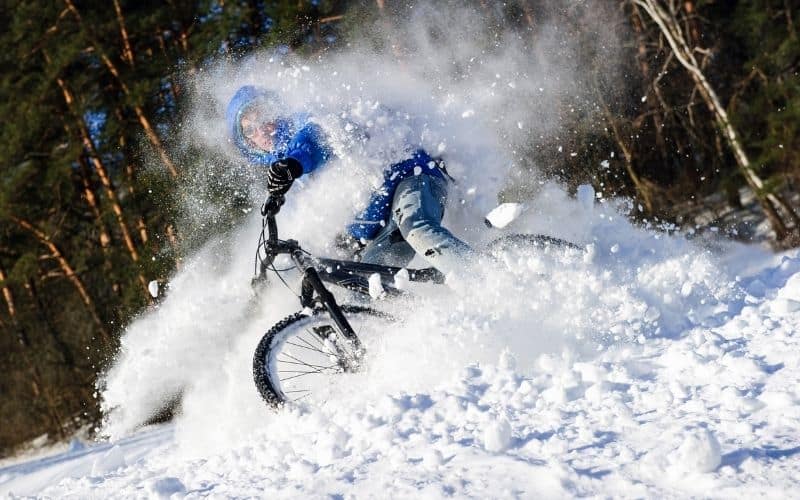Love it or hate it, the winter season happens across the globe, and for one-third of the Earth, that means months upon months of snow.
This doesn’t necessarily mean it is time to put the mountain bike in storage to collect dust for the dreary winter months.
Many cyclists ride all year round, obviously, a feat such as this does require a few minor tweaks to your cycling routine, but many bikers take great joy in hitting the trail directly after a fresh snowfall.
This article will examine the dos and don’ts of winter cycling and the best ways to keep yourself warm, safe, and in shape.
Contents
Are Mountain Bikes Good for Winter?
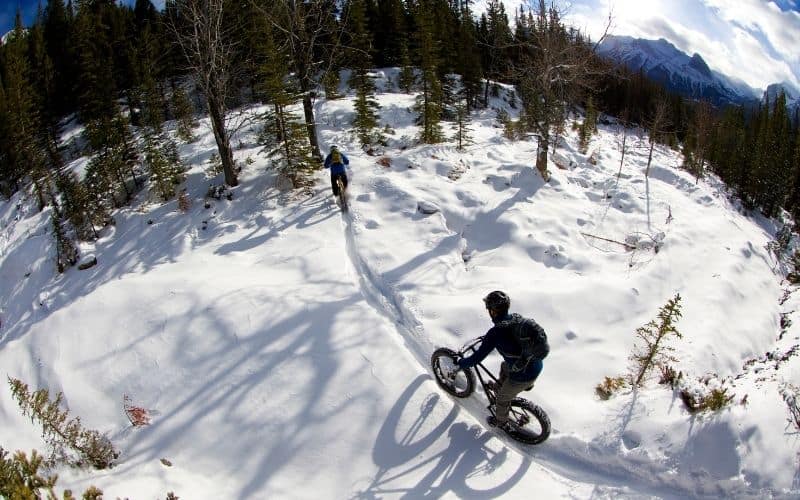
While a mountain bike might not be the absolute best for riding in winter conditions, it is leagues above other styles of bikes for many reasons.
It would be unthinkable to attempt to ride a road bike or something similar to a comfort bike on a trial, let alone one covered in snow.
Mountain bikes are designed to be versatile and adapt to any terrain they may encounter, this includes snow and ice.
With their knobby tires, front suspension, and superb durability, mountain bikes do make out quite well in snowy conditions.
There are a few things to keep in mind before heading out the door.
How do you Mountain Bike in the Winter?
If you decide you are ready to hit those snowy trails or simply want to commute to work all year round, there are a few things to keep in mind before putting rubber to the icy-cold pavement. Some of these things include:
- Proper Gear (for person and bike)
- Appropriate tires
- Speed
- Safety
Let’s examine each of these elements a little closer.
1. Proper Gear
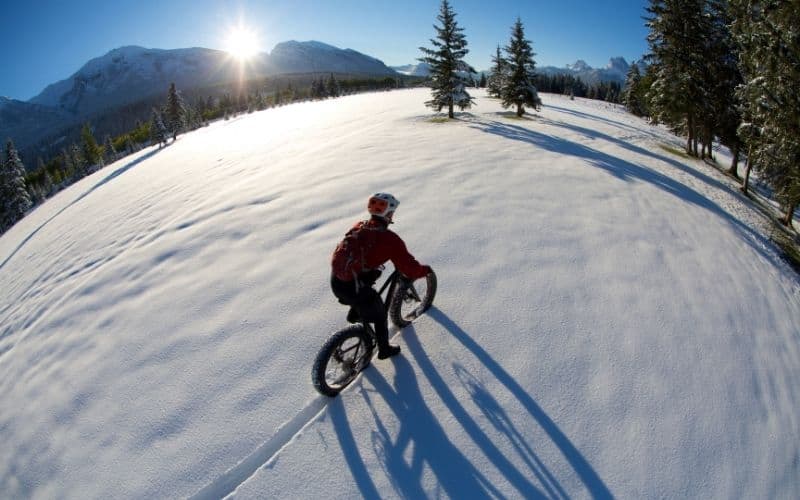
When speaking of the proper gear to use when biking in the snow, there are two aspects that need to be taken into consideration. Those being some modifications to the bike and the gear worn by the rider.
It goes without saying that if there is snow on the ground, it is cold outside. It is of the utmost importance to keep yourself safe on the trail and that includes keeping yourself warm.
If at all possible, attempt to outfit yourself with the following to ensure the greatest amount of safety and comfort:
- Insulated helmets (skiing helmets work well)
- Goggles
- Balaclava/Face protection
- Gloves
- Multiple layers of clothing
The best practice is to make sure that all outer layers are waterproof, and all inner layers are wool, this will keep you the warmest and driest.
When shopping for your outermost layers, it is also a good idea to look for a color that is vibrant. As the winter months tend to be a bit darker, it is a good idea to keep yourself visible out there.
When getting your bike ready to hit the snow-covered streets, there are a few techniques you can try to make your trip safer.
A good place to start is the…
2. Tires
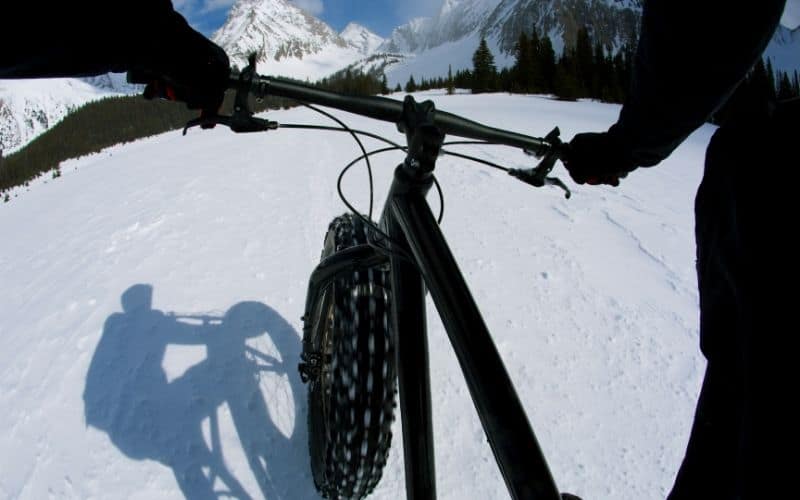
The main catalyst of safety in winter conditions is going to be the tires. Start by adjusting the air pressure in your bike tires to see which best suits your set-up.
What usually ends up being the case is, the lower the tire pressure, the smoother the ride. This is the case for a number of reasons.
Firstly, the lower the tire pressure, the more “give” your tire will have, this means you will have a slight increase in suspension. This should amount to an easier time with those unseen roots and rocks.
Secondly, you will have more tire that is in contact with the ground, which should equate to not only a more enjoyable ride but also improved stability.
Another way to greatly increase the comfort of your ride is to invest in studded tires. These are similar to your standard mountain bike tires but are riddled with tiny metal studs which bite into the snow and ice to help you keep your bike upright.
If you are interested in studded tires but don’t have the ability to purchase a set, there are numerous sources online which can teach you how to stud your own tires. Keep in mind there is no way to un-stud your tires as most methods require you to pierce the rubber of your preexisting set.
3. Speed
With snow on the ground, your bike’s performance is going to instantly decrease and by this we mean the snow is going to slow you down drastically.
When riding a bike, one usually associates speed with stability but in winter conditions this doesn’t happen to be the case.
When riding at any speed, it is difficult to tell what is snow, what is ice, and what is pavement. For this reason, it is in your best interest to keep your speed slow and steady.
You may have to tack on some extra time to your commute but arriving at your destination safely is priority number one.
4. Safety
When braving any conditions on a bike, safety should always be top of mind and when adding the element of snow and ice, it becomes that much more important.
While reviewing your route or trial and going through the checklist of precautions, one may start to wonder…
Is Mountain Biking in Snow Dangerous?
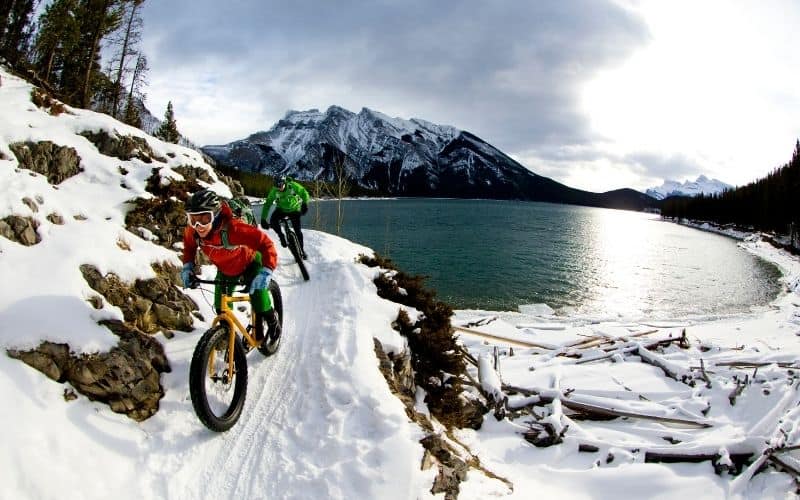
There is no debate that ice makes things more dangerous, whether that be walking, driving, or biking.
A mountain bike is not specifically designed to handle snowy or icy conditions, it is made to withstand the downhill terrain of a mountain.
To answer the question, yes using your mountain bike in the snow is more dangerous than on dry pavement. While this is the case, this doesn’t mean that it should be avoided, only approached with a greater level of caution.
Here is a quick review of how to keep yourself safe out there:
Be visible! As the winter months tend to be darker, it is extremely important to make sure that other vehicles and cyclists can see you. This can be accomplished in a number of ways including LED lights, vibrantly-colored outer layers, or even a reflective vest.
Wear a helmet. This won’t just protect your brain but can also keep your head warm if you do choose to go with a skiing helmet.
Wear layers and keep warm. One of the most important things to remember in those frigid conditions is to stay warm. That means making sure to keep your head, hands, and feet as warm and dry as possible.
Slow down, plan your route carefully and leave early. A good rule of thumb is, if you have to lean into turns you are going too fast. This is an especially bad practice in snowy conditions as you reduce the surface area the tire covers.
Which Bike is Best for Snowy Conditions?
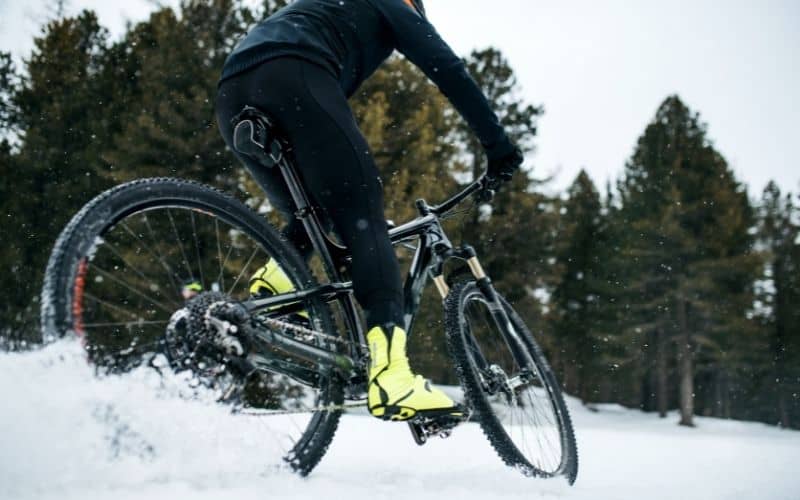
There seems to be a bicycle for every type of condition and yes, that includes snow and ice.
The fat bike is designed specifically for riding on soft and unstable terrain, such as snow, sand, and mud.
This bike has comically sized tires which are inflated to a low tire pressure which allows them to effortlessly maneuver any unfortunate terrain.
The frame is quite similar to that of a mountain bike, although usually fat bikes are void of the front suspension that most mountain bikes have as the large tires provide sufficient suspension.
A fat bike may be a good investment if you are located somewhere with long winters, or you enjoy the comfort it provides.
One drawback that many mountain bikers find when riding a fat bike is the decrease in speed between the two.
Both the large tires and the heavier frame contribute to making the fat bike slower, but in most cases, a rider will want a decreased speed when operating this bike.
In Conclusion
It is obvious that the person who coined the name “Mountain Bike” was pulling no punches, this bicycle is indeed designed to handle the harsh terrain of a mountain.
This doesn’t mean that if handled correctly, a mountain bike can’t become a completely suitable candidate for those cold and unfortunate winter days.
In Finland, it is actually quite common for people of all age groups to cycle all year round, even though the ground is covered in snow for roughly half the year.
If you do brave those arctic conditions, remember to always wipe your bike down whenever you reach your destination. Between the water and salt on the roads, your trusty steed will surely become a rusty steed if you leave it to drip dry.
It is also a good idea to think about purchasing a waterproof backpack, especially if you want to ride your bike to work or the gym.
If you take into consideration all the aforementioned recommendations, you shouldn’t have any issues tearing up your city on that mountain bike year-round.
Not only does this contribute to a healthier planet, but also makes for one incredible workout.
Dress warm, slow down, and be safe out there.
